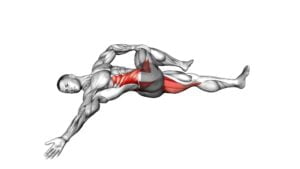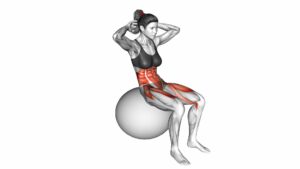Spinal Stretch (On Stability Ball) (Male) – Video Exercise Guide & Tips

Get ready to improve your flexibility and strengthen your core with the Spinal Stretch on a stability ball.
Watch This Exercise Video
This exercise guide and video will show you the proper form and technique, as well as provide tips for different fitness levels.
Avoid common mistakes and learn how to incorporate this stretch into your routine.
Get ready to feel the benefits of this effective exercise.
Key Takeaways
- Spinal Stretch on a stability ball improves flexibility, relieves tension, and enhances spinal mobility.
- Proper form and technique include sitting on the stability ball with feet flat on the floor, engaging core muscles, and avoiding jerking movements.
- Equipment needed for the exercise includes a stability ball, mat, comfortable clothing, and proper footwear.
- Modifications for different fitness levels include adjusting intensity and duration, gradually increasing the stretch, and consulting with a healthcare professional if needed.
Benefits of the Spinal Stretch
Experience the numerous benefits of the Spinal Stretch exercise to improve flexibility and relieve tension in your spine. Spinal flexibility is crucial for maintaining good posture and preventing back pain. By incorporating the Spinal Stretch into your exercise routine, you can enhance the flexibility of your spine, allowing for greater range of motion and improved overall mobility.
The Spinal Stretch specifically targets the muscles surrounding the spine, including the erector spinae, which run along the length of the spine. By stretching and lengthening these muscles, you can alleviate any tightness or discomfort that may be causing back pain. Additionally, the Spinal Stretch helps to decompress the spine, relieving pressure on the intervertebral discs and promoting spinal health.
Regular practice of the Spinal Stretch can also help to improve your posture. By lengthening the spine and opening up the chest, this exercise encourages proper alignment and reduces the risk of developing a rounded or hunched posture. Good posture not only improves your appearance, but also reduces strain on the spine, decreasing the likelihood of experiencing back pain.
Incorporating the Spinal Stretch into your exercise routine can provide significant benefits for spinal flexibility and back pain relief. By committing to regular practice, you can experience improved flexibility, reduced tension, and enhanced spinal health.
Proper Form and Technique
To ensure proper form and technique for the Spinal Stretch exercise on a stability ball, it's important that you maintain a stable position while engaging your core muscles. This exercise is designed to stretch and lengthen the muscles of the spine, promoting flexibility and spinal health.
To begin, sit on the stability ball with your feet flat on the floor and your knees bent at a 90-degree angle. Slowly walk your feet forward, allowing the ball to roll underneath you until your mid-back is resting comfortably on the ball. Keep your feet hip-width apart and your arms crossed over your chest.
As you exhale, engage your core muscles and slowly extend your back over the ball, allowing your spine to gently stretch. It's important to avoid any jerking or bouncing movements during this exercise.
Common misconceptions about the Spinal Stretch exercise on a stability ball include the belief that you need to arch your back excessively or that you should feel pain during the stretch. In reality, the goal is to maintain a neutral spine position and focus on a gentle, controlled stretch.
Variations and progressions of the Spinal Stretch exercise can be done by using different sizes of stability balls or by adding resistance by holding a weight plate or dumbbell against your chest. Remember to always consult with a qualified fitness professional before attempting new variations or progressions to ensure proper form and minimize the risk of injury.
Equipment Needed for the Exercise
For the Spinal Stretch exercise on a stability ball, you'll need the following equipment:
- Stability Ball: The stability ball is the main piece of equipment needed for this exercise. It provides an unstable surface that challenges your core muscles and improves balance. Using a stability ball also allows for a greater range of motion, enhancing the effectiveness of the stretch.
- Mat: It's advisable to use a mat underneath the stability ball to provide cushioning and prevent slipping. This will ensure your safety and comfort throughout the exercise.
- Comfortable Clothing: Wearing comfortable clothing is essential for unrestricted movement during the Spinal Stretch. Opt for flexible and breathable fabrics that allow you to move freely without any discomfort.
- Proper Footwear: While not directly related to the equipment, wearing proper footwear is important to maintain stability and prevent any potential injuries. Choose athletic shoes with good traction and support to ensure a safe and effective workout.
Having the right equipment for the Spinal Stretch exercise is crucial for maximizing the benefits of stretching and ensuring your safety. By using a stability ball, mat, comfortable clothing, and proper footwear, you can perform the exercise with ease and reap the rewards of improved flexibility and spinal health.
Modifications for Different Fitness Levels
To modify the Spinal Stretch exercise on a stability ball for different fitness levels, you can adjust the intensity and duration of the stretch. For beginners or individuals with limited flexibility, start with a gentle stretch, holding the position for 10-15 seconds. As you progress, gradually increase the duration to 30 seconds or longer. To increase the intensity, you can try extending your arms overhead or lifting your legs off the ground while maintaining balance on the stability ball. These progression options challenge your core stability and enhance the effectiveness of the exercise.
When modifying the Spinal Stretch, it's important to prioritize injury prevention. Make sure to listen to your body and avoid any movements that cause discomfort or pain. If you have any existing back or neck injuries, consult with a healthcare professional before attempting this exercise. Additionally, always maintain proper form and alignment to minimize the risk of injury. Engage your core muscles to stabilize your spine throughout the movement and avoid excessive arching or rounding of the back.
Now that you understand the modifications for different fitness levels, let's move on to the next section and discuss common mistakes to avoid during the Spinal Stretch exercise.
Common Mistakes to Avoid
When performing the spinal stretch on a stability ball, it's important to avoid common mistakes that can lead to incorrect form and potential dangers.
One common mistake isn't maintaining proper alignment of the spine, which can put unnecessary strain on the back.
Another mistake isn't fully engaging the core muscles, which reduces the effectiveness of the exercise and increases the risk of injury.
Incorrect Form Dangers
Avoiding incorrect form when performing the spinal stretch on a stability ball is essential to prevent potential dangers. Incorrect form can lead to common injuries such as strains, sprains, and muscle imbalances. To ensure your safety and maximize the benefits of this exercise, keep the following points in mind:
- Proper alignment: Maintain a neutral spine throughout the exercise to avoid excessive stress on the vertebrae.
- Engage core muscles: Activate your abdominal and lower back muscles to stabilize your body and protect your spine.
- Controlled movements: Avoid jerky or rapid movements that can strain your muscles or cause loss of balance.
- Gradual progression: Start with a smaller range of motion and gradually increase as your flexibility and stability improve.
Lack of Core Engagement
Ensure proper core engagement during the spinal stretch on a stability ball to prevent potential dangers and maximize the benefits of the exercise. Core strengthening is crucial for overall stability and proper body mechanics. The core muscles, including the abdominals, back muscles, and pelvic floor, provide a strong foundation for movement and support for the spine. Neglecting core engagement during the spinal stretch can lead to ineffective results and increase the risk of injury.
By actively contracting your core muscles throughout the exercise, you stabilize the spine and enhance the effectiveness of the stretch. Maintaining core stability also helps to maintain proper alignment and posture, reducing strain on the lower back. By prioritizing core engagement, you can optimize the benefits of the spinal stretch and minimize the risk of injury.
Now let's move on to some tips for incorporating the spinal stretch into your routine.
Tips for Incorporating the Spinal Stretch Into Your Routine
To effectively incorporate the spinal stretch into your routine, start by positioning yourself on the stability ball. This exercise provides a great opportunity to improve flexibility and strengthen the muscles surrounding your spine. Here are some tips to help you make the most out of the spinal stretch:
- Incorporate variations: Explore different variations of the spinal stretch to target different areas of your spine and promote overall spinal health. You can try stretching to the side, forward, or even rotating your upper body while maintaining stability on the ball. This will engage different muscle groups and enhance the benefits of the exercise.
- Focus on breathing techniques: Pay attention to your breathing during the spinal stretch. Inhale deeply through your nose as you prepare to stretch, and exhale slowly through your mouth as you move into the stretch. This controlled breathing technique will help you relax and optimize the stretch.
- Gradually increase intensity: Start with gentle stretches and gradually increase the intensity over time. This will allow your muscles to adapt and prevent any potential injuries. Listen to your body and avoid pushing yourself too far too quickly.
- Maintain proper form: While performing the spinal stretch, ensure that your spine is aligned and your core is engaged. This will help you maximize the benefits and avoid strain on your back.
Frequently Asked Questions
How Long Should I Hold the Spinal Stretch Position?
To properly perform the spinal stretch, it's important to hold the position for an appropriate amount of time. The duration of the stretch will depend on your comfort level and flexibility.
It's generally recommended to hold the spinal stretch position for about 20 to 30 seconds. This allows enough time for the muscles in your back to lengthen and release tension.
Remember to listen to your body and adjust the duration as needed to avoid any discomfort or strain.
Can the Spinal Stretch Help With Lower Back Pain?
The spinal stretch has several benefits that can help with lower back pain. By stretching the muscles and ligaments in your back, it can relieve tension and improve flexibility.
The technique involves using a stability ball to support your body while you gently stretch your spine. This exercise can also help improve posture and strengthen the core muscles.
Incorporating the spinal stretch into your routine may provide relief and prevent future episodes of lower back pain.
Is It Normal to Feel Discomfort During the Spinal Stretch?
Feeling discomfort during the spinal stretch is normal. It's because the stretch is actively working on your back muscles, which may cause some initial discomfort. However, this discomfort shouldn't be severe or painful.
The benefits of the spinal stretch include improving flexibility, reducing tension in the back muscles, and relieving lower back pain over time. Remember to listen to your body and stop if the discomfort becomes too intense.
Can I Do the Spinal Stretch if I Have a Previous Back Injury?
If you have a previous back injury, it's important to be cautious when doing the spinal stretch. Consult with a healthcare professional for proper back injury management and to determine if the spinal stretch is suitable for you.
There may be alternative exercises for back injury that can help improve flexibility and relieve discomfort. It's crucial to prioritize safety and avoid exacerbating any existing issues.
How Often Should I Incorporate the Spinal Stretch Into My Exercise Routine?
To maximize the benefits of the spinal stretch, you should incorporate it into your exercise routine regularly. The frequency of the stretch will depend on your individual needs and goals.
However, it's generally recommended to perform the spinal stretch at least 2-3 times per week. This will help improve flexibility, relieve tension in the spine, and promote better posture.
Remember to consult with a healthcare professional before starting any new exercise routine, especially if you have a previous back injury.
Conclusion
Incorporating the spinal stretch on a stability ball into your routine offers several benefits, including improved flexibility, posture, and spinal health.
By following proper form and technique, using the necessary equipment, and making modifications based on your fitness level, you can maximize the effectiveness of this exercise.
Avoid common mistakes and remember to stretch gently without overexertion.
With these tips in mind, you can confidently incorporate the spinal stretch into your fitness routine for optimal results.

Author
Years ago, the spark of my life’s passion ignited in my mind the moment I stepped into the local gym for the first time. The inaugural bead of perspiration, the initial endeavor, the very first surge of endorphins, and a sense of pride that washed over me post-workout marked the beginning of my deep-seated interest in strength sports, fitness, and sports nutrition. This very curiosity blossomed rapidly into a profound fascination, propelling me to earn a Master’s degree in Physical Education from the Academy of Physical Education in Krakow, followed by a Sports Manager diploma from the Jagiellonian University. My journey of growth led me to gain more specialized qualifications, such as being a certified personal trainer with a focus on sports dietetics, a lifeguard, and an instructor for wellness and corrective gymnastics. Theoretical knowledge paired seamlessly with practical experience, reinforcing my belief that the transformation of individuals under my guidance was also a reflection of my personal growth. This belief holds true even today. Each day, I strive to push the boundaries and explore new realms. These realms gently elevate me to greater heights. The unique combination of passion for my field and the continuous quest for growth fuels my drive to break new ground.







